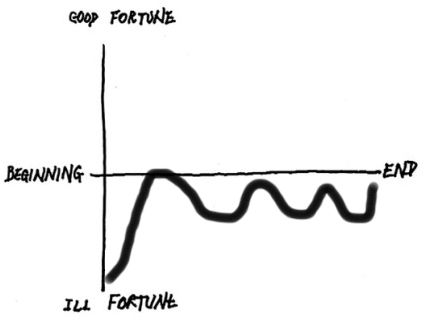I recently watched Philip Noyce’s 2010 Angelina Jolie vehicle Salt on Netflix. As I recall, it wasn’t well-received when it came out. Some people had issues with its implausibility, as if implausibility isn’t inherent in action-adventure films. In the movie, we find out that the lead character, Evelyn Salt, is a CIA agent. The we find out she’s a Russian agent. Hollywood being Hollywood, we know she’s not going to turn out to be a villain, but we can at least play along with the story that the issue is up in the air. That uncertainty makes the story interesting to me, but I can see how others might be turned off by the lack of clarity.

I’m thinking about how Vonnegut’s story shapes would apply. It’s a little tricky because the chronology is not linear, but I’m going to take the start of the movie as the beginning and the end as the end, and ignore the flashbacks and what gets hidden in the leap forward. There are a few different ways of looking at it. The story starts out in ill fortune, as she’s being interrogated in North Korea. From there it goes to the median line, as we see her in her regular daily life. She spends the rest of the film on the run, so we could call that ill fortune, but she also has her escapes and victories along the way, so we could also see it as going up and down. Broadly, I think it fits the Cinderella shape, as she dispatches the bad guys, saves the world, and manages to convince counterintelligence that she’s on the side of the good guys. But in the version I saw (apparently there was a different one with an alternate ending (YT) she’s still on the run in the end. Perhaps the fact that it doesn’t clearly hold to a familiar story shape is why it was not well-received. Her situation is never really resolved.
If we were to include the flashback sections in chronological order, that would change the shape of the story. But since the story isn’t told that way, it would also change the story. There is a storytelling principle of “show, don’t tell.” Here’s an example from the classic rock radio that woke me up in the morning:
On a dark desert highway, cool wind in my hair
Warm smell of colitas, rising up through the air
It paints a picture with words, rather than just telling us the singer was driving through the desert at night. In a song the showing can be done poetically, with an economy of language. In film it’s more challenging because exposition usually has to shown in real time, and time is a limited commodity. The flashbacks in Salt show us something about where the character comes from and what motivates her, which is more effective than having someone tell us her background. Perhaps it’s more poetic in a way too.
I’m also thinking about Bryan Alexander’s chapter on digital storytelling. One of the overall questions driving the course is, “What is digital storytelling?” although I try to keep it implicit so as not to be limiting. I like his approach of asking what it is not, and the challenge that question creates. Is Salt digital storytelling? So much media these days is born digital, edited and produced and distributed digitally. I tend to think of it in terms of the web. The web’s power comes from the hyperlink, from connecting and embedding documents into a larger story. A movie is a movie and a TV show is a TV show, perhaps not DS. But on the web they can be connected with other narratives, sub-narratives and meta-narratives, to be part of a larger story. What I’m doing here is trying to weave some things together, songs and lyrics and thoughts and reflections, hopefully to say something and show something more than just a few paragraphs. Hopefully more than rambling drivel too.

